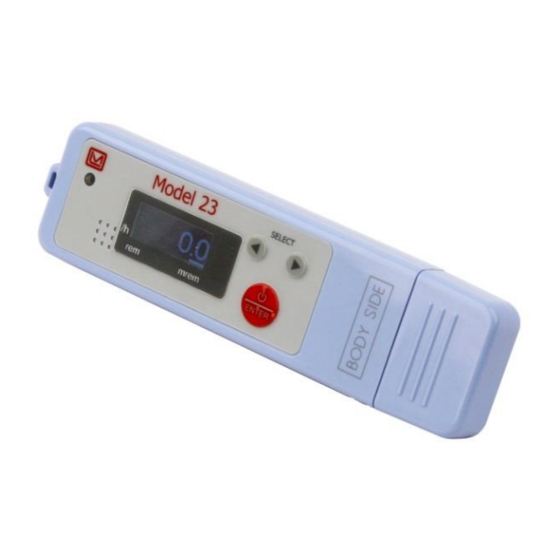Table of Contents
Advertisement
Quick Links
Advertisement
Table of Contents

Summary of Contents for Ludlum Measurements 23
- Page 1 MODEL 23 AND 23-1 ELECTRONIC PERSONAL DOSIMETER August 2017...
- Page 2 MODEL 23 AND 23-1 ELECTRONIC PERSONAL DOSIMETER August 2017...
-
Page 4: Statement Of Warranty
RETURN OF GOODS TO MANUFACTURER If equipment needs to be returned to Ludlum Measurements, Inc. for repair or calibration, please send to the address below. All shipments should include documentation containing return shipping address, customer name, telephone number, description of service requested, and all other necessary information. - Page 5 Ludlum Measurements, Inc. August 2017...
-
Page 6: Table Of Contents
Packing and Repacking Battery Installation Preparing the Instrument for Use Operating the Instrument Specifications Description of Controls and Functions Parts and Features Display Alarm Safety Considerations Environmental Conditions for Normal Use Precautions Cleaning Instructions Recycling Ludlum Measurements, Inc. August 2017... -
Page 7: Introduction
The Model 23-1 is identical to the Model 23, except that it measures in Sv/h instead of R/hr. The compact and lightweight body of the instrument (55.9 g {2 oz}) makes it ideal for personal use. -
Page 8: Getting Started
Replace the battery with the following procedure: 1. Press and hold the power switch (color: red) for approximately two seconds until the Model 23 turns off. 2. Remove the battery door. 3. Extract the used battery using miniature pliers or something similar and insert the new battery with the negative (-) side facing upward. - Page 9 Technical Manual Section 2 Caution: Always turn off the Model 23 EPDi before replacing the battery. Be sure to observe proper polarity when replacing the battery. This product operates on the CR2450 battery (3.0 V) only (Part # 21-8639). Only use the battery specified.
-
Page 10: Preparing The Instrument For Use
Technical Manual Section 2 Preparing the Instrument for Use To start the Model 23 EPDi, press and hold the power switch (color: red) for approximately two seconds. When the measurement screen appears, the red LED lamp lights for one second and one short beep sounds, indicating that the Model 23 is in the measurement mode. -
Page 11: Specifications
Sensitivity: 600 records (optional IR reader required for data Data Logging: transmission to PC). When the Model 23 is turned off, the accumulative dose data is automatically deleted. Default Settings: Dose alarm threshold: regular alarm 0.5 mSv; pre-alarm 0.3 mSv Dose rate alarm threshold: regular alarm 4 mSv/h;... - Page 12 Model 23 & 23-1 Technical Manual Section 3 operates properly after a vertical drop test from 20 cm Shock Resistant: one each coin-type lithium battery (CR2450) Power: typically one month at 8 hours per day in non-alarm status Battery Life: 12 x 30 x 112.8 mm (0.5 x 1.2 x 4.4 in.) (H x W x D) without clip...
-
Page 13: Description Of Controls And Functions
Model 23 & 23-1 Technical Manual Section 4 Section Description of Controls and Functions Parts and Features Strap Hole LED lamp Selection Buttons Power Switch Buzzer Display Infrared Communication Window Battery Cover Clip Ludlum Measurements, Inc. Page 4-1 August 2017... -
Page 14: Display
Technical Manual Section 4 Display Display at the end of normal operation Indicates that the Model 23 is operating in the measurement mode. Display at the time of abnormal operation Alarm indications: ALM DOSE (dose) ALM RATE (dose rate) ... - Page 15 Model 23 & 23-1 Technical Manual Section 4 Ludlum Measurements, Inc. Page 4-3 August 2017...
-
Page 16: Alarm
Model 23 & 23-1 Technical Manual Section 4 Alarm ALM DOSE When the dose or the dose rate of Five 0.1-second beeps ALM RATE gamma rays reaches preset values, sound every second. the pre-alarm activates ALM DOSE When the dose or dose rate of... -
Page 17: Safety Considerations
Pollution Degree 2 (as defined by IEC 664) JIS Waterproof Grade 1: water resistant under normal living conditions Notice! The Model 23 Dosimeter may not measure pulsed radiation accurately. Also, do not use it as a survey meter. Warning: To prevent short-outs, protect exposed terminals with insulating tape prior to disposal. -
Page 18: Cleaning Instructions
Caution! Do not force open the clip, as it may be damaged. Cleaning Instructions The Model 23 Dosimeter may be cleaned externally with a dry cloth if contaminated with dirt. Caution! The operator or responsible body is cautioned that the protection provided by the equipment may be impaired if the equipment is used in a manner not specified by Ludlum Measurements, Inc. -
Page 19: Recycling
To this end, Ludlum Measurements, Inc. strives to supply the consumer of its goods with information regarding reuse and recycling of the many different types of materials used in its products. With many different agencies - public and private - involved in this pursuit, it becomes evident that a myriad of methods can be used in the process of recycling.

















Need help?
Do you have a question about the 23 and is the answer not in the manual?
Questions and answers